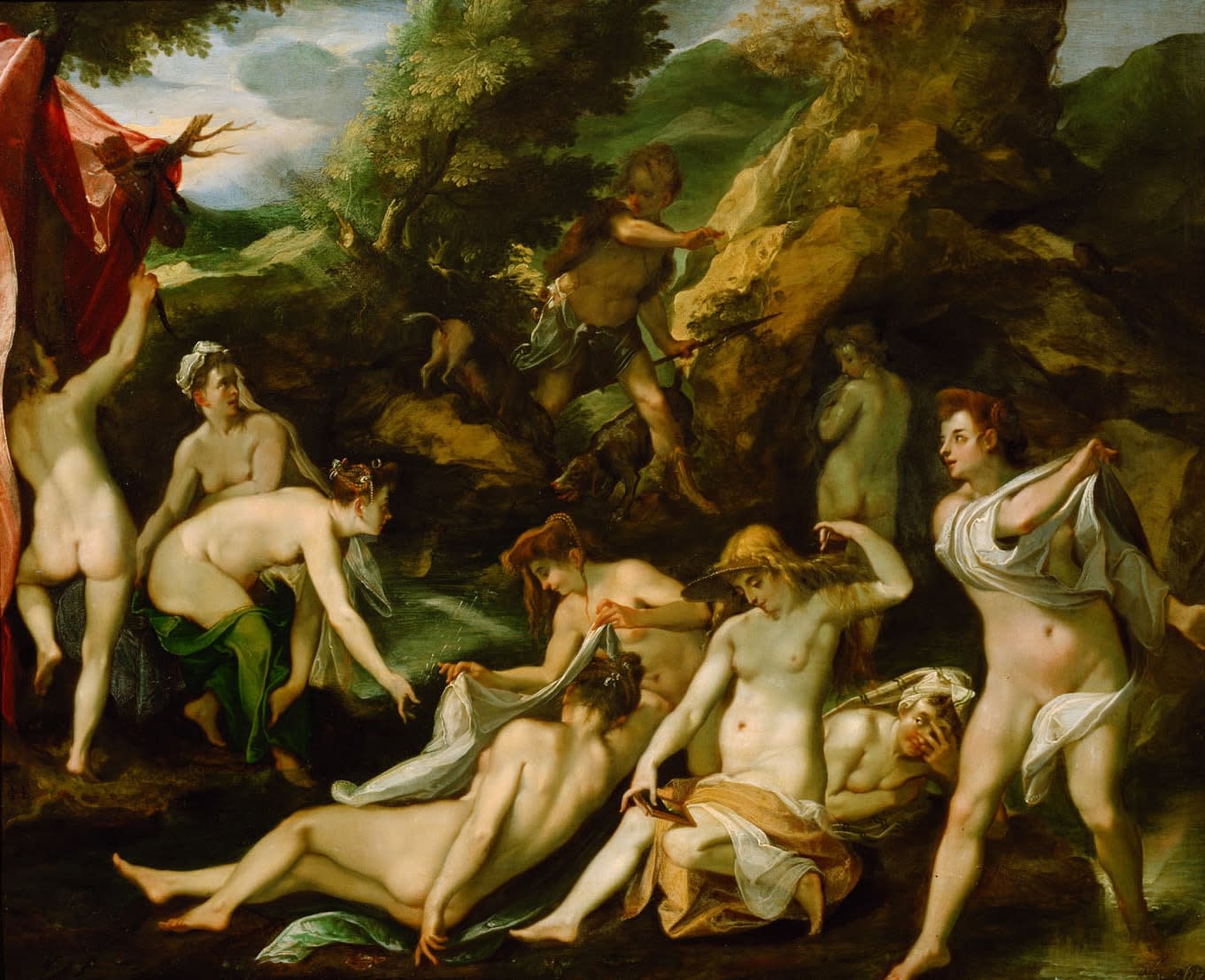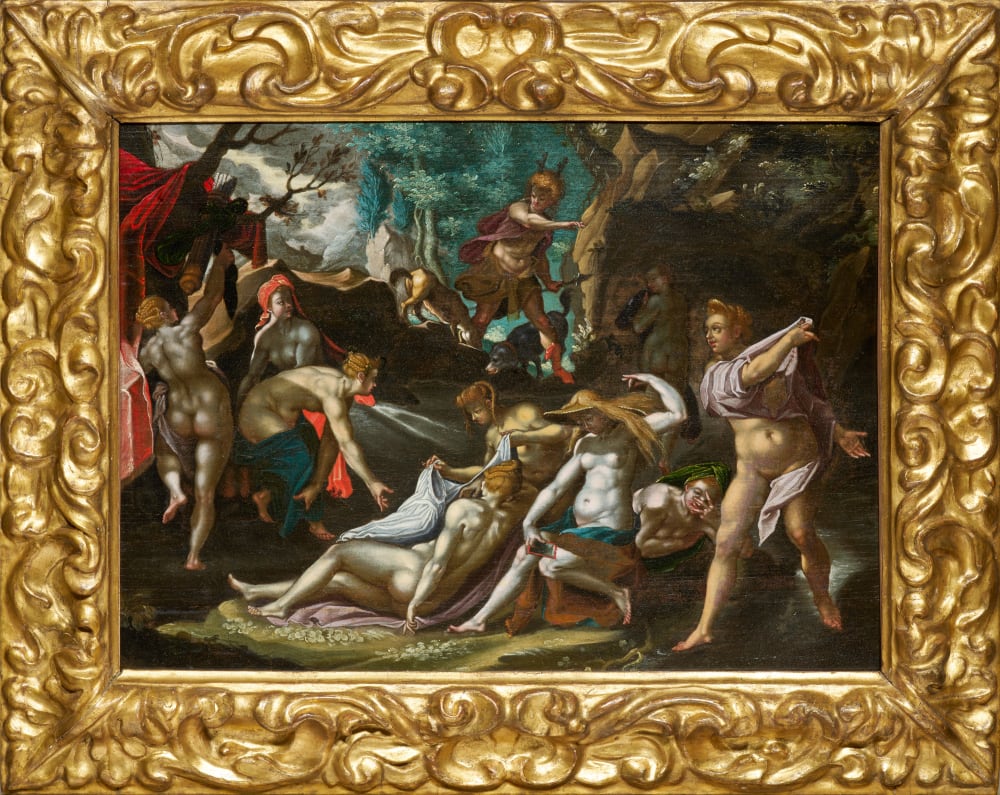 Joseph Heintz the Elder - Diana and Actaeon - Kunsthistorisches Museum, Vienna - Austria
Joseph Heintz the Elder - Diana and Actaeon - Kunsthistorisches Museum, Vienna - Austria
 Aegidius Sadeler II - Diana and Actaeon © Wellcome Trust - London - United Kingdom
Aegidius Sadeler II - Diana and Actaeon © Wellcome Trust - London - United Kingdom
Joseph Heintz the Elder 1564-1609
36.5 x 50.3 cm
Plus d'images
-
(View a larger image of thumbnail 1
)

-
(View a larger image of thumbnail 2
)

-
(View a larger image of thumbnail 3
)

-
(View a larger image of thumbnail 4
)

-
(View a larger image of thumbnail 5
)

-
(View a larger image of thumbnail 6
)

-
(View a larger image of thumbnail 7
)

-
(View a larger image of thumbnail 8
)

-
(View a larger image of thumbnail 9
)

-
(View a larger image of thumbnail 10
)

Provenance
Private collection, Parma - Italy/ collection particulière - Parme - ItalieThis painting seduced us with its rich colors. Depicting Diana and her companions surprised by Actaeon, it was inspired by an engraving by Aegidius Sadeler II after a painting by Joseph Heintz the Elder now in the Kunsthistorisches Museum in Vienna.
This subject was a huge success and many artists, all anonymous, were inspired by this engraving. The vivid colors used in this painting suggest that it was probably executed in the first quarter of the 17th century by a Nordic artist, perhaps during his stay in Italy.
1. Joseph Heintz the Elder, a great artist of the Mannerist school
Joseph Heintz the Elder was born in Basel in 1564, where he apprenticed in the studio of Hans Bock the Elder (1550 - 1624). He was also inspired by the works of Hans Holbein the Younger, who had stayed in the city between 1515 and 1526.
In 1583 Joseph Heintz went to Italy and became a pupil of Hans von Aachen in Rome, before travelling to Florence and then Venice. In 1591, he was called to the court of Rudolf II in Prague, where he became his official portraitist. His stay in Prague lasted only two years, as he then returned to Italy to make copies of ancient works for the emperor before settling in Augsburg, where his son, also called Joseph, was born in 1600. His son in turn became a painter under the name of Joseph Heintz the Younger.
2. From the Vienna painting to the engraving by Aegidius Sadeler II
The original painting by Joseph Heintz the Elder is thought to have been painted between 1590 and 1600. It may have been commissioned by Rudolf II, as it reflects his taste for mythological scenes tinged with eroticism. It is now in the Kunsthistorisches Museum in Vienna.
This painting enjoyed a certain renown very early on, as it was engraved by Aegidius Sadeler II (1570 - 1629), an Antwerp engraver who settled in Prague in 1597.
Although the engraving is faithful to the painting by Joseph Heintz the Elder, it differs in a few details, all of which are later reproduced in our painting (as in most other versions painted after this engraving). Starting from the left, we can see that the scabbard hanging in the tree is oriented differently, that the tree behind Actaeon has become straight, and that a tree has been added to the right above the rock forming a sort of grotto. While the engraver has emphasized the muscularity of the bodies, he has given Actaeon a fuller head of hair, and quite significantly reshaped the face of the woman standing on the far right.
3. Description of our painting
The scene depicted is inspired by a famous episode from Ovid's Metamorphoses (III 138-252). After a day's hunting, Actaeon, a young hunter, stumbles upon the sacred grotto where the goddess Diana and her nymphs are bathing. Furious at having been seen, Diana sends him a few drops of water that cause him to transform into a stag. Actaeon the hunter becomes a hunted beast, and he is eventually devoured by his hounds.
Joseph Heintz focused his painting on the representation of the group formed by the goddess, wearing her attribute (a crescent moon) and leaning forward to spray Actaeon, and her nymphs. Some of them are dressing hastily, while others are still enjoying this moment of rest.
The only notable change made by our painter to the engraving is to have crowned Actaeon's head with stag horns; this variant also appears in other copies made after Sadeler's engraving.
This painting is both rudimentary and sophisticated. The picture is painted directly onto the panel without any preparatory layer to soften the striations on the wood. The bodies, whose joints are briefly outlined with a few black lines, are drawn in a vigorous and geometric manner. But the interest - and the delight - of our painting lies in the very rich range of colors chosen to illustrate this episode.
Starting from a black and white engraving, it is likely that our painter had never seen the delicate green and pink polychromy of the original painting. In this choice of colors he demonstrated a real capacity for innovation, modulating the bodies of the nymphs from milky white to more amber tones and distributing the strident colors characteristic of Mannerism in the fabrics: carmine red, parma, orange or aniseed green.
One detail is highly representative of both the narrative verve of Heintz the Elder and our painter's taste for color. Unaffected by the surrounding tumult, a blonde beauty contemplates herself in a mirror while trying on a hat. Behind her is the most charming detail of our painting: a turbaned nymph who, like a child, hides behind the three fingers of her hand.
This close-up shows both the painter's skill at rendering detail (in the delicacy of the fingers partly covering the nymph’s face) and his immense skill as a colorist, since he does not hesitate to introduce a bright aniseed green alongside the astonishing azure blue cape (lined with orange!) that is resting on the lap of our blonde beauty.
4. The success of a theme spread through engraving
The engraving of Heintz the Elder’s painting ensured the success of this scene, which was widely reproduced: Marco Cannone, whom we would like to thank for his contribution, has listed 22 faithful copies, all of which were executed by anonymous artists after Sadeler's engraving (6 are on copper, 6 on wood, 9 on canvas and one on parchment). The two best-known copies are kept in two Italian museums, the Accademia in Venice and the Galeria Nazionale in Rome.
The only difference between these two copper plate versions is the color of the fabrics. In these versions, the nude bodies are closer to the original work, while in our painting they are much closer to the muscular treatment of the engraving, accentuating the Mannerist flavor of our painting.
5. Framing
We chose an Italian frame from the 17th century, whose auricular patterns are particularly well-suited to accompany this debauchery of flesh and swirl of colors.
Main bibliographical reference :
Jürgen Zimmer - Joseph Heintz der Ältere als Maler (1564 -1609) - 1971








